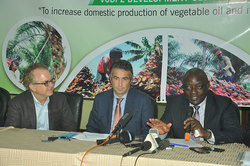
R-L: Minister Vincent Ssempijja, IFAD country representative Alessandro Marini and researcher Prof Edward Taylor
Oil palm project to be extended to other districts
by ARTHUR MATSIKO AND WINNIE NABAASA
Government is in advanced discussions with the International Fund for Agricultural Development (IFAD) to extend the oil palm project beyond Kalangala district.
Since the inception of the oil palm project in 2005, Kalangala, which is made of 84 islands, has been enjoying the monopoly of cultivating of oil palm in the country.
After about 13 years of implementation of the first phase, IFAD and ministry of Agriculture, Animal Industry and Fisheries (MAAIF) are in discussions to extend the project to other districts across the country under the second phase of the project.
Under the second phase, which has been delayed by about 5 years, IFAD earmarked $53m for the project. The oil palm project will expand to Buvuma island in Mukono district where government already secured 5,600 hectares of land in 2011. The second phase will focus on oilseed development around four hubs (Lira, Eastern Uganda, Gulu and West Nile) covering 43 districts.
Speaking to The Observer in Kampala, IFAD country representative, Alessandro Marini, said the important issue is the project’s impact on the rural communities.
“The investment in Kalangala is almost through; we are not investing anymore in Kalangala. We are planning on an investment of ten years to cover another four investment hubs in Uganda,” said Marini.
“We are definitely considering replicating the success of Kalangala to the other districts in partnership with ministry of Agriculture and the private sector.”
By September 2017, about 10,000 hectares of oil palm trees had been planted, with 6,500 hectares operated by Oil Palm Uganda Limited (OPUL) in the form of a nucleus estate. The remaining 3,500 hectares belong to 1,800 individual smallholders who sell their fresh fruit bunches to one of two local mills operated by OPUL.
As part of the project, government and IFAD established the Kalangala Oil Palm Growers Trust, for farmers to access credit. Current loans total $13 million to smallholder growers, and about $4 million has been paid back.
According to a 2018 Local Economy-wide Impact Evaluation of the Kalangala Oil Palm Project report, there has been a reduction in fishing activities and an increase in household income through oil palm production and business linkages.
Under the umbrella of the Vegetable Oil Development Project (VODP), promotion of oil palm production has been seen as a strategic effort to address high poverty rates and reduce Uganda’s dependency on oil imports by increasing domestic production.
Prof Edward Taylor, lead researcher on the impact of the oil palm interventions in Kalangala, told us that a one-acre increase in oil palm increases income in Kalangala by Shs 2.2 million. To him, this impact implies the project’s viability of. Taylor also attributed the reduction of fishing activities on the islands to oil palm growing.
“Traditionally, fishing has been an extremely important activity in Kalangala, but it has been a troubled activity because Lake Victoria is being overfished and so the fish harvest has been decreasing,” said Taylor.
“What we found in our study is that as the mature fruit-bearing acreage of oil palm trees expands, people fish less.”
A statistical analysis of the correlation between fishing and oil palm cultivation indicates a 28.8 per cent reduction in the likelihood of an individual participating in fishing activities once his or her household begins to harvest from oil palm groves (4 years after planting).
Asked as to whether emphasis on oil palm production would not create food insecurity, minister for Agriculture Vincent Bamulangaki Ssempijja said income from oil palm would help farmers to access food.
“Food security has some connotation with income, although the agreement is that every farmer who joins the project of growing palm oil must retain two acres [to grow] food crops,” says Ssempijja.
The first phase of the $35m project was funded by IFAD in partnership with the government of Uganda. The palm oil project in Kalangala was conceived in 1997 when IFAD approved the Vegetable Oil Development Project (VODP).
As a result, government in 2004 signed an agreement with OPUL, which brought on board private investors to partner with government to push the crop.
Originally, the total project cost was $60 million, consisting of an IFAD loan of $20 million, $33.1 million of co-financing from the private sector partner, $3.8 million from the government of Uganda and $3.1 million from beneficiaries.
However, due to an increase in the scale of the Oil Palm Subproject, the private investor and the government increased their contributions to $120 million and $12 million respectively, bringing the total cost to about $156 million.
A 2012 report titled ‘Land, life and Justice: How land grabbing in Uganda is affecting the environment, livelihoods and food sovereignty of communities’ released by Friends of the Earth International (FOEI) pinned the oil palm project in Kalangala district for the growing deforestation.
The report noted that the oil palm project, which currently sits on 10,000 hectares of the island’s land, has wiped away many trees. VODP maintains that none of the protected areas have been touched and even then, according to officials where some trees have been cut by farmers, they have replanted palm, which are also trees.











